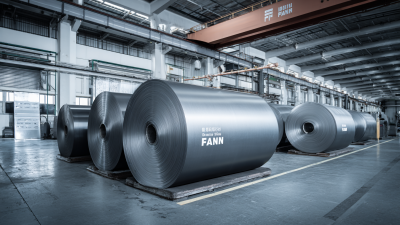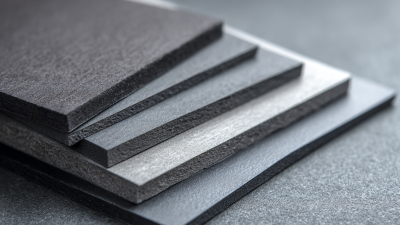Understanding the Role of Graphite Thermal Film in Modern Electronics
As the demand for high-performance electronics continues to rise, the efficiency of thermal management solutions has become a critical focus for manufacturers. Among these solutions, Graphite Thermal Film has emerged as a leading material due to its exceptional thermal conductivity, lightweight properties, and flexibility. According to a recent report from MarketsandMarkets, the global market for thermal interface materials, including graphite films, is expected to reach USD 4.2 billion by 2025, growing at a CAGR of 10.2%. This acceleration signifies a robust interest in innovative materials that can enhance device performance while minimizing heat-related failures.
Leading experts in the field have underscored the importance of Graphite Thermal Film. Dr. Emily Choi, a renowned physicist specializing in thermal management materials, stated, "Graphite Thermal Film stands out for its capability to efficiently dissipate heat across various components, making it indispensable in the design of modern electronics." Her insights reflect the broader industry perspective that prioritizes advanced thermal solutions to meet the increasing performance demands of devices ranging from smartphones to high-performance computing systems.
In this context, understanding the advantages and applications of Graphite Thermal Film becomes essential for both developers and consumers. As we explore the "Top 5" reasons why this material is transforming modern electronics, it becomes evident that its role is pivotal in shaping the future of thermal management strategies across multiple sectors.

The Importance of Graphite Thermal Film for Efficient Heat Management in Electronics
Graphite thermal film has emerged as a critical component for efficient heat management in modern electronics. As devices become more compact and powerful, the challenge of dissipating heat effectively becomes paramount. Graphite thermal films offer a unique combination of high thermal conductivity, lightweight properties, and flexibility, making them ideal for various electronic applications, from smartphones to high-performance computing systems.
The ability of graphite thermal film to conduct heat away from critical components ensures that devices operate within optimal temperature ranges. This not only boosts performance but also extends the lifespan of electronic components. Furthermore, the thinness of these films allows for integration in tight spaces, which is essential in today’s design trends that prioritize slim profiles without sacrificing functionality. By facilitating efficient heat dissipation, graphite thermal films play a vital role in preventing overheating, ultimately enhancing reliability and user satisfaction in modern electronics.
Heat Management Efficiency in Electronics with Graphite Thermal Film
Key Industry Statistics Highlighting the Growth of Graphite Thermal Film Market
The graphite thermal film market has been experiencing remarkable growth, driven by the increasing demand for efficient thermal management solutions in various modern electronic applications. According to recent industry statistics, the market is projected to expand at a compound annual growth rate (CAGR) of over 10% in the next five years. This growth can be attributed to the rising prevalence of high-performance computing systems, mobile devices, and electric vehicles, all of which require effective cooling mechanisms to enhance performance and longevity.
As industries embrace innovation, it is crucial for manufacturers to recognize the importance of selecting the right thermal management materials. Tips for choosing graphite thermal films include assessing thermal conductivity, thickness, and flexibility. Ensuring optimal thermal efficiency can not only improve device performance but also reduce energy consumption. Additionally, investing in high-quality materials can significantly impact the end product's reliability and overall climate impact.
Moreover, the versatility of graphite thermal films continues to open new avenues across various sectors. With advancements in production techniques, the availability of tailored solutions is increasing, allowing for customization that meets specific performance requirements. By keeping abreast of these industry trends and statistics, businesses can effectively strategize to harness the potential of graphite thermal films in their products.
Understanding the Role of Graphite Thermal Film in Modern Electronics - Key Industry Statistics Highlighting the Growth of Graphite Thermal Film Market
| Year | Market Size (USD Million) | Growth Rate (%) | Key Applications | Region |
|---|---|---|---|---|
| 2020 | 250 | 5.0 | Consumer Electronics | North America |
| 2021 | 270 | 8.0 | Automotive | Europe |
| 2022 | 290 | 7.4 | Industrial Electronics | Asia-Pacific |
| 2023 | 310 | 6.9 | Telecommunications | South America |
| 2024 | 340 | 9.7 | Healthcare Devices | Middle East |
Comparative Analysis of Graphite Thermal Film and Traditional Cooling Solutions
The evolution of thermal management solutions in electronics showcases a pivotal shift from traditional cooling methods to innovative materials like graphite thermal films. Traditional cooling solutions, such as heat sinks and fans, often struggle with limitations in efficiency and space. In contrast, graphite thermal films provide superior thermal conductivity, enabling more effective heat dissipation in compact electronic designs. This transformation is crucial in modern electronics, where minimizing thermal buildup can significantly enhance performance and longevity.
Furthermore, the integration of graphite thermal films is not only an advancement in cooling technology but also aligns with the broader trends towards sustainable energy solutions. As industries strive to adopt greener practices, the lightweight and efficient thermal management capabilities of graphite films contribute to lowering energy expenditure and improving the sustainability of electronic devices. In the face of ongoing challenges, such as machining heat-resistant superalloys in aerospace applications, these emerging technologies illustrate a commitment to bridging traditional and modern approaches in the quest for more sustainable thermal energy systems.
Applications of Graphite Thermal Film in Cutting-edge Electronic Devices
Graphite thermal film has emerged as a crucial component in the realm of modern electronics, especially in high-performance devices that require efficient thermal management. One of the most prominent applications of this innovative material is in smartphones and tablets, where it helps dissipate heat generated by powerful processors and graphics chips. By effectively spreading and transferring heat away from critical components, graphite thermal film not only enhances device performance but also prolongs the lifespan of electronic gadgets.
In addition to mobile devices, graphite thermal film plays a significant role in gaming consoles and laptops, where sustained performance is paramount. It is also increasingly being utilized in electric vehicles, where thermal management is essential for battery efficiency and safety. The lightweight and flexible nature of graphite thermal film allows it to be seamlessly integrated into diverse form factors, making it a versatile solution for manufacturers aiming to deliver cutting-edge technology. As the demand for thinner, faster, and more powerful electronics continues to rise, the importance of graphite thermal film in maintaining optimal thermal performance cannot be overstated.

Future Trends in Graphite Thermal Film Technology and Its Impact on Electronics
As technology advances, the role of graphite thermal films in electronics is becoming increasingly crucial. These films are utilized for their exceptional thermal conductivity, which allows for effective heat dissipation in compact electronic devices. With the growing demand for high-performance and energy-efficient gadgets, graphite thermal films are set to play a significant role in evolving cooling solutions, catering to the needs of modern electronics.

Future trends in graphite thermal film technology include the integration of nanomaterials to improve performance and flexibility. Researchers are exploring new composites that combine graphite with other materials to enhance thermal management while reducing weight and thickness.
Furthermore, as the miniaturization of electronics continues, the necessity for effective thermal solutions will only intensify, driving innovation in manufacturing techniques. These advancements could lead to more sustainable practices in the electronics industry as companies look to improve energy efficiency and lifespan of devices, ultimately transforming how thermal films contribute to the technology landscape.
Related Posts
-

Top 10 Thermal Graphite Sheet Manufacturers from China at the 137th Canton Fair
-

China's Leading Edge: The Evolution of the Best Graphite Thermal Sheets in Global Manufacturing
-

Exploring the Future: Advances in Graphite Thermal Film Technology by 2025
-

Understanding Industry Standards and Reasons Behind the Best Graphite Thermal Sheet Selection
-

What is Flexible Graphite Sheet and How It Revolutionizes Industrial Applications?
-

How to Choose the Right Graphite Thermal Sheet for Your Application